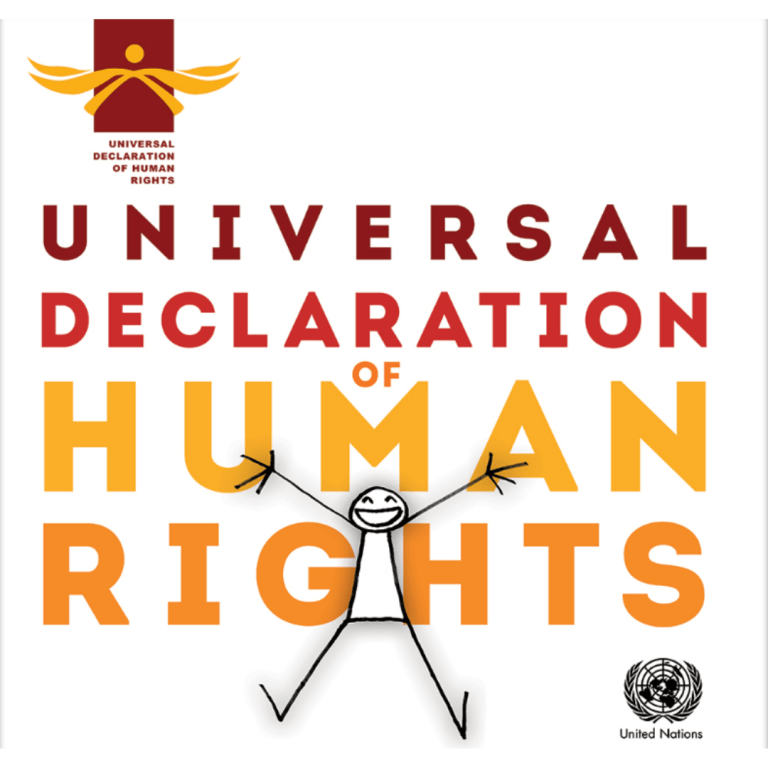December is Universal Human Rights Month and this past Sunday (December 10th) was the 75th commemoration of the adoption of the Universal Declaration of Human Rights by the UN. The declaration was formed three years after the ratification of the United Nations charter. In the wake of the horrors of World War II there was a strong impetus to establish both a peacekeeping body and an agreed set of fundamental human rights to be universally protected.
Among the rights in the declaration are:
- All human beings are born free and equal in dignity and rights.
- Everyone has the right to life, liberty and security of person.
- No one shall be subjected to torture or to cruel, inhuman or degrading treatment or punishment.
- All are equal before the law and are entitled without any discrimination to equal protection of the law.
There are over 30 articles in the declaration, ensuring freedom of movement, right to asylum, right to education, freedom of peaceful assembly, freedom of opinion and expression, freedom of religion, and right to privacy among others. It recognizes the right to marry and equal rights and dignity in employment. Article 25 specifically addresses the right to medical care:
“Everyone has the right to a standard of living adequate for the health and well-being of himself and of his family, including food, clothing, housing and medical care and necessary social services, and the right to security in the event of unemployment, sickness, disability, widowhood, old age or other lack of livelihood in circumstances beyond his control. (United Nations, 1948)”
The United States is a signatory to the Declaration. Despite this, our government does not always live up to the ideals of the document. The structure of the health care system in the US does not support the standard of universal care guaranteed in Article 25 and the US has failed to ratify most of the international treaties that include a right to health (Willen, 2019). FDR advocated a Second Bill of Rights to include the right to “adequate medical care and the opportunity to achieve and enjoy good health” in his 1944 State of the Union. President Truman was also an advocate of a national health insurance program tied to Social Security. But in the 1940’s private health insurance became more common in the US, covering about half of the population, and the insurance industry created a barrier to further proposals for a national health program at the federal level (Berkowitz, 2005).
The Johnson administration established Medicare and Medicaid in 1965 after a many years long fight and negotiation with the insurance industry. It was largely successful because it covered vulnerable populations who typically were too high risk to be privately insured. For decades many Americans fell through the gaps between the coverage of those programs and private insurance.
While the Affordable Care Act of 2010 brought affordable health care to millions more, the country still fails to provide care to everyone and the current complex system of public and private funding increases inefficiencies and costs. A post pandemic study documented how our “fragmented and inefficient health care system” cost over 200,000 more lives and billions more in expenses during the Covid pandemic than a single payer system would have (Galvani, et al. 2022). A 2022 survey published by KFF (formerly Kaiser Family Foundation) estimates that 41% of adults currently have some debt as a result of medical or dental treatment and one in 10 has significant medical debt. A quarter say they have debt that is past due or that they are unable to pay. One in four black adults, lower-income adults, and uninsured don't think they will ever pay off their health care debt.
A January 2023 Gallup poll found that 57% of Americans say the government should guarantee health coverage for everyone, but a 53% majority want to preserve the current private insurance system. The AMA endorses expanding ACA and Medicare while preserving the current system of private insurance while Physicians for a National Health Insurance Program advocates for a non-profit single payer system. The American Academy of Family Physicians takes the middle ground of laying out multiple options to get to universal care including a single payer model, a public option, and Medicare/Medicaid buy in.
However it is achieved, further progress in health care reform is necessary to provide the universal coverage all Americans deserve and reduce the costs and inefficiencies that are negatively impacting the delivery of healthcare in the US.
Sources
Berkowitz E. (2005). Medicare and Medicaid: the past as prologue. Health care financing review, 27(2), 11–23.
Galvani, A. P., Parpia, A. S., Pandey, A., Sah, P., Colón, K., Friedman, G., Campbell, T., Kahn, J. G., Singer, B. H., & Fitzpatrick, M. C. (2022). Universal healthcare as pandemic preparedness: The lives and costs that could have been saved during the COVID-19 pandemic. Proceedings of the National Academy of Sciences of the United States of America, 119(25), e2200536119. https://doi.org/10.1073/pnas.2200536119
United Nations (1948). Universal Declaration of Human Rights. https://www.un.org/en/about-us/universal-declaration-of-human-rights
Willen S. S. (2019). Invoking Health and Human Rights in the United States: Museums, Classrooms, and Community-Based Participatory Research. Health and Human Rights, 21(1), 157–162.


